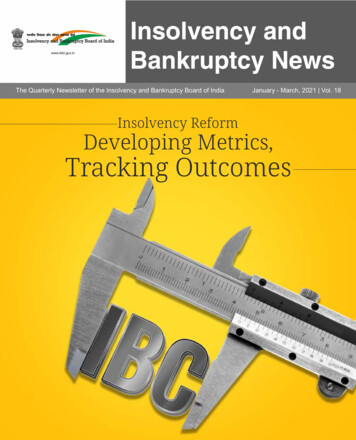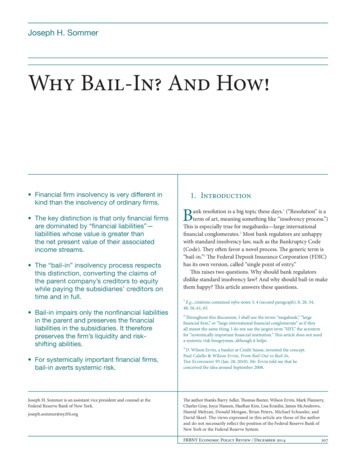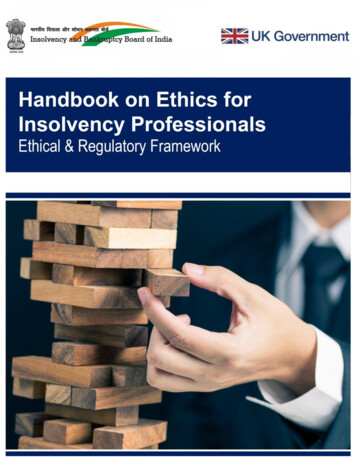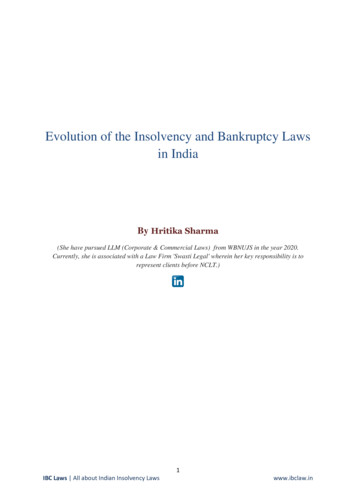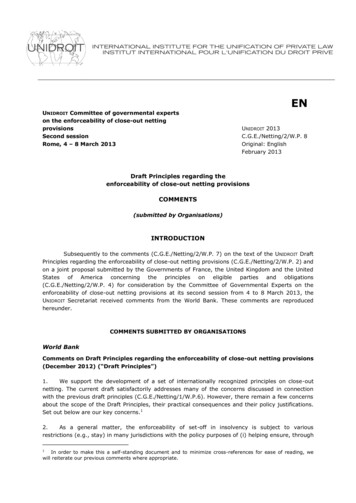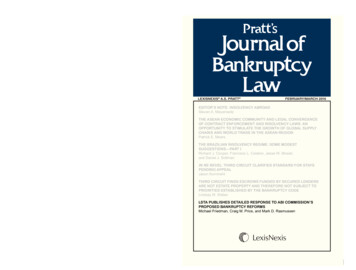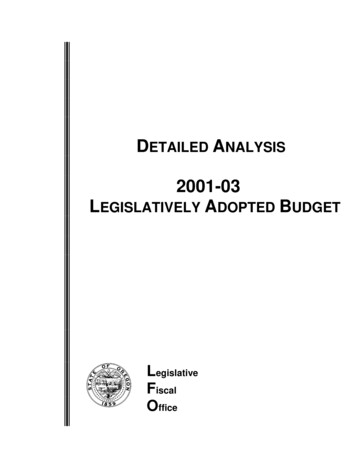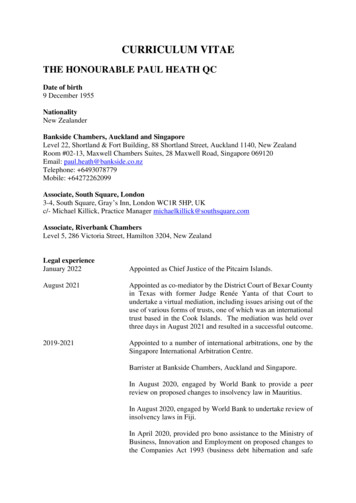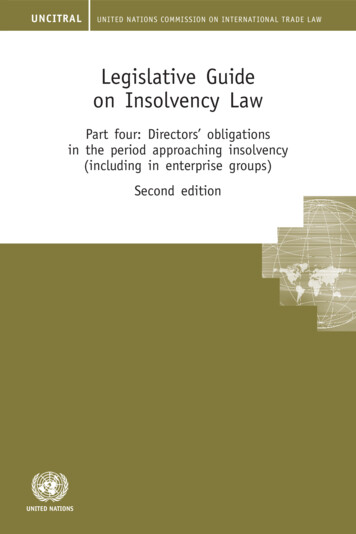
Transcription
UNCITRALUNITED NAT IONS COMMISSION ON INTERNAT IONAL TRADE L AWLegislative Guideon Insolvency LawPart four: Directors’ obligationsin the period approaching insolvency(including in enterprise groups)Second editionUNITED NATIONS
United Nations Commission on International Trade LawLegislative Guideon Insolvency LawPart four: Directors’ obligationsin the period approaching insolvency(including in enterprise groups)Second editionUNITED NATIONSVienna, 2020
NoteSymbols of United Nations documents are composed of letters combinedwith figures. Mention of such symbols indicates a reference to a UnitedNations document.UNITED NATIONS PUBLICATIONe-ISBN 978-92-1-004806-4 United Nations, February 2020. All rights reserved.The designations employed and the presentation of material in this p ublication donot imply the expression of any opinion whatsoever on the part of the Secretariatof the United Nations concerning the legal status of any country, territory, city orarea, or of its authorities, or concerning the delimitation of its frontiers orboundaries.Publishing production: English, Publishing and Library Section, United NationsOffice at Vienna.ii
ContentsParagraphsIntroduction and purpose of part four . . . . . . . . . . . . . . . . . . . . . . . . . .Page1Section oneObligations of directors of an enterprise in the periodapproaching the insolvency of that enterpriseIntroduction and purpose of section one . . . . . . . . . . . . . . . . . .1-33I. Background . . . . . . . . . . . . . . . . . . . . . . . . . . . . . . . . . . . . . . . . . . . . . .1-155 II. Elements of directors’ obligations in the periodapproaching insolvency . . . . . . . . . . . . . . . . . . . . . . . . . . . . . . . . .1-4411A. The nature of the obligations . . . . . . . . . . . . . . . . . . . . . . .1-711Recommendations 255-256 . . . . . . . . . . . . . . . . . . . . . . . . . . . B. When the obligations arise: the periodapproaching insolvency . . . . . . . . . . . . . . . . . . . . . . . . . . . . . .158-12Recommendation 257 . . . . . . . . . . . . . . . . . . . . . . . . . . . . . . . . .C. Identifying the parties who owe the obligations . . . .1813-16Recommendation 258 . . . . . . . . . . . . . . . . . . . . . . . . . . . . . . . .D. Liability . . . . . . . . . . . . . . . . . . . . . . . . . . . . . . . . . . . . . . . . . . . . . .181917-35Recommendations 259-261 . . . . . . . . . . . . . . . . . . . . . . . . . . .E. Enforcement of the directors’ liabilities . . . . . . . . . . . .16202636-44Recommendations 262-266 . . . . . . . . . . . . . . . . . . . . . . . . . . .2629Section two bligations of directors of enterprise group companiesOin the period approaching insolvencyIntroduction and purpose of section two . . . . . . . . . . . . . . . . . .iii1-331
Glossary . . . . . . . . . . . . . . . . . . . . . . . . . . . . . . . . . . . . . . . . . . . . . . . . . . . .432I. Background . . . . . . . . . . . . . . . . . . . . . . . . . . . . . . . . . . . . . . . . . . .1-11331-13371-437II.E lements of the obligations of directors ofenterprise group members in the periodapproaching insolvency . . . . . . . . . . . . . . . . . . . . . . . . . . . . . .A.The nature of the obligations . . . . . . . . . . . . . . . . . . .Recommendations 267–268 . . . . . . . . . . . . . . . . . . . . .B. Identifying the persons who owe theobligations . . . . . . . . . . . . . . . . . . . . . . . . . . . . . . . . . . . . . . .C.Conflict of obligations . . . . . . . . . . . . . . . . . . . . . . . . . .385-8419-1342Recommendations 269–270 . . . . . . . . . . . . . . . . . . . . .44Annex V. Decisions of the United Nations Commissionon International Trade Law, adopted on18 July 2013 and 15 July 2019,and General Assemblyresolution 68/107 B . . . . . . . . . . . . . . . . . . . . . . . . . . . . . .45iv
Legislative Guideon Insolvency LawPart four: Directors’ obligationsin the period approaching insolvency(including in enterprise groups)Second editionIntroduction and purpose of part fourThe purpose of part four is to identify basic principles to be reflected in the lawconcerning directors’ obligations in the period approaching insolvency. In the present second edition, an additional section has been included to address theenterprise group insolvency context. Section one addresses the key elements ofdirectors’ obligations in the period approaching insolvency. It does so in the context of an individual company when that company faces imminent insolvency, orits insolvency becomes unavoidable. Building on section one, section two addresseshow some of the recommendations contained in section one could be revised forapplication to directors in the enterprise group insolvency context. It identifiesthe extent to which a director of an enterprise group member may take accountof considerations beyond the enterprise group member he or she manages in theperiod approaching insolvency and the safeguards that should apply. It also includesadditional recommendations to address situations when a director faces a conflictin discharging the obligations owed to the different enterprise group members.1
Section oneObligations of directors of an enterprisein the period approaching the insolvencyof that enterpriseIntroduction and purpose of section one1. This section focuses on the obligations that might be imposed upon thoseresponsible for making decisions with respect to management of an enterprisewhen that enterprise faces imminent insolvency or insolvency becomes unavoidable. The aim of imposing such obligations, which are enforceable once insolvencyproceedings commence, is to protect the legitimate interests of creditors and otherstakeholders and to provide incentives for timely action to minimize the effects offinancial distress experienced by the enterprise.2. The key elements of provisions imposing such obligations are addressed,including (a) the nature and extent of the obligations, (b) the time at which theobligations arise, (c) the persons to whom the obligations would attach, (d) liabilityfor breach of the obligations, (e) enforcement of the obligations, (f) applicabledefences, (g) remedies, (h) the persons who may bring an action to enforce theobligations, and (i) how those actions might be funded.3. This section uses terminology common to other parts of the Guide and otherinsolvency texts prepared by UNCITRAL.1 To provide orientation to the reader,this section should be read in conjunction with terms and explanations includedin the glossary contained in the Introduction to the Guide.21 Available from uncitral.un.org under “Texts and Status”.2 United Nations publication, Sales No. E.05.V.10.3
I.Background1. Corporate governance frameworks regulate a set of relationships between acompany’s management, its board, its shareholders and other stakeholders andprovide not only the structure through which the objectives of the company areestablished and attained, but also the standards against which performance canbe monitored. Good corporate governance should provide incentives for theboard and management to pursue objectives that are in the interests of the company and its shareholders, as well as fostering the confidence necessary for promoting business investment and development. Much has been done at theinternational level to develop widely adopted principles of corporate governancethat include the obligations of those persons responsible for making decisionsconcerning the management of an enterprise (in this part referred to as“directors”3) when it is solvent.2. Once insolvency proceedings commence, many insolvency laws recognize thatthe obligations of directors will differ both in substance and focus from those applicable prior to the commencement of those proceedings, with the emphasis on prioritizing maximization of value and preservation of the estate for distribution tocreditors. Often directors will be displaced from ongoing involvement in the company’s affairs by an insolvency representative, although under some insolvency lawsthey may still have an ongoing role, particularly in reorganization. Part two, chapterIII of the Guide addresses several possibilities for the role the debtor may play in thecontinuing operation of the business, including retention of full control, limited displacement, and total displacement (recommendation 112 and paras. 10-18). Thechapter also addresses the obligations of the directors once insolvency proceedingscommence (recommendations 108-114 and paras. 22-34). Recommendation 110specifies in some detail the obligations that should arise under the insolvency law oncommencement of insolvency proceedings and continue throughout those proceedings, including obligations: to cooperate with and assist the insolvency representativeto perform its duties; to provide accurate, reliable and complete information relatingto the financial position of the company and its business affairs; and to cooperatewith and assist the insolvency representative in taking effective control of the estateand facilitating recovery of assets and business records. The imposition of sanctions3 The question of who may be considered a director for the purposes of this part is discussed in this sectionbelow in chap. II, paras. 13-16. Although there is no universally accepted definition of the term, this part refersgenerally to “directors” for ease of reference.5
6 Legislative Guide on Insolvency Law—Part fourwhere the debtor fails to comply with those obligations is also addressed (recommendation 114 and paras. 32-33).3. Effective insolvency laws, in addition to providing a predictable legal processfor addressing the financial difficulties of troubled enterprises and the necessaryframework for their efficient reorganization or orderly liquidation, should also permit an examination to be made of the circumstances giving rise to insolvency andin particular the conduct of directors of such an enterprise in the period beforeinsolvency proceedings commence. However, little has been done internationallyto harmonize the various approaches of national law that might facilitate examination of that conduct and significant divergences remain. The nature and extent ofthe obligations directors might have in that period when the business might beexperiencing financial distress but is not yet insolvent or subject to insolvencyproceedings are not well established, but they are increasingly the subject of extensive debate, particularly in view of widespread failures following the global financialcrisis of 2008.4. A business facing an actual or imminent inability to meet its obligations asthey fall due needs robust management, as often there are difficult decisions andjudgments to be made that will be critical to the company’s survival, with corresponding benefits to its owners, creditors, customers, employees and others.Competent directors should understand the company’s financial situation and possess all reasonably available information necessary to enable them to take appropriate steps to address financial distress and avoid further decline. At such times, theyare faced with choosing the course of action that best serves the interests of theenterprise as a whole, having weighed the interests of the relevant stakeholders inthe circumstances of the specific case. Under some laws, those stakeholders willbe the corporation itself and its shareholders. Under other laws, it may involve abroader community of interests that includes creditors. Directors concerned withpersonal liability and the possible financial repercussions of making difficult decisions in those circumstances may prematurely close down a business rather thanseek to trade out of the problems, they may engage in inappropriate behaviour,including unfairly disposing of assets or property or they may also be tempted toresign, often adding to the difficulties that the company is facing.5. The different interests and motivations of stakeholders are not easy for directors and managers to balance and provide a potential source of conflict. For example, shareholders of an enterprise, who typically are unlikely to share in anydistribution in insolvency proceedings, are interested in maximizing their ownposition by seeking to trade out of insolvency or to hold out on any potential salein the hope of a better return, especially where the sale price would cover onlycreditor claims and leave nothing for shareholders. Such courses of action mayinvolve adopting high-risk strategies to save or increase value for shareholders, at
1. Obligations of directors of an enterprise in the period approaching the insolvency of that enterprise 7the same time putting creditors’ interests at risk. Those actions may also reflectlimited concern for the chances of success because of the protection of limitedliability or director liability insurance if the course of action adopted fails.6. Despite the potential difficulties associated with taking appropriate businessdecisions, when a company faces financial difficulties it is essential that early actionbe taken. Financial decline typically occurs more rapidly than many parties wouldbelieve and as the financial position of an enterprise worsens, the options availablefor achieving a viable solution also rapidly diminish. That early action must befacilitated by ease of access to relevant procedures; there is little to be gained byurging directors to take early action if that action cannot be directed towardsrelevant and effective procedures.4 Moreover, those laws that expose directors toliability for trading during the conduct of informal procedures such as voluntaryrestructuring negotiations (discussed in part one, chap. II, paras. 2-18) may operateto deter early action. While there has been an appropriate refocusing of insolvencylaws in many countries to increase the options for early action to facilitate rescueand reorganization of enterprises, there has been little focus on creating appropriateincentives for directors to use those options. Often, it is left to creditors to pursuethose options or commence formal insolvency proceedings because the directorshave failed to act in a timely manner.7. A number of jurisdictions address the issue of encouraging early action byimposing an obligation on a debtor to apply for commencement of formal insolvency proceedings within a specified period of time after insolvency occurs in orderto avoid trading whilst insolvent. Other laws address the issue by focusing on theobligations of directors in the period before the commencement of insolvency proceedings and imposing liability for the harm caused by continuing to trade whenit was clear or should have been foreseen that insolvency could not be avoided.The rationale of such provisions is to create appropriate incentives for early actionthrough the use of restructuring negotiations or reorganization and to stop directors from externalizing the costs of the company’s financial difficulties and placingall the risks of further trading on creditors.8. The imposition of such obligations has been the subject of continuing debate.Those who acknowledge that such an approach has advantages point out that theobligations may operate to encourage directors to act prudently and take early stepsto stop the company’s decline with a view to protecting existing creditors fromeven greater losses and incoming creditors from becoming entangled in the company’s financial difficulties. Put another way, the obligations may also have the effectof controlling and disciplining directors, dissuading them from embracing4 It has been suggested that the dearth of cases under insolvent trading legislation in one State is because ofthe relative ease of access to voluntary procedures and only those companies that are hopelessly insolvent areultimately liquidated.
8 Legislative Guide on Insolvency Law—Part fourexcessively risky courses of action or passively acquiescing to excessively riskyactions proposed by other directors because of the sanctions attached to the failureto perform the obligations. An associated advantage may be that they provide anincentive to directors to obtain competent professional advice when financial difficulties loom.9. Those commentators who suggest that there are significant disadvantages citethe following examples. A rule that presumes mismanagement based solely on thefact of financial distress often causes otherwise knowledgeable and competent directors to leave a company, and the opportunity to reorganize that company and returnit to profitability is missed. There is a possibility that directors seeking to avoid liability will prematurely close a viable business which otherwise could have survived,instead of attempting to trade out of the company’s difficulties. Properly drafted provisions would discourage overly hasty closure of businesses and encourage directorsto continue trading where that is the most appropriate way of minimizing loss tocreditors and are more likely to balance the rights and legitimate expectations of allstakeholders, distinguishing cases of bad conduct from those involving market conditions or other exogenous factors. A further disadvantage cited is that the obligationsmay be regarded as an erosion of the legal status brought by incorporation, althoughit can be argued that limited liability should be seen as a privilege and courts havebeen alive to the potential for abuse of limited liability where it is to the detrimentof creditors. Such obligations might also be regarded as a weakening of enterpriseincentives on the basis that too much risk may discourage directors. Properly draftedprovisions, however, would focus not so much on the causes of distress, but ratheron the directors’ acts (or omissions) subsequent to that point. Examples from jurisdictions that include such obligations in their laws suggest that only the most clearlyirresponsible directors are found liable.10. It is also said that such obligations may increase unpredictability, becauseliability depends on the particular circumstances of each case and also on the futureattitudes of the courts. It is suggested that many courts lack the experience to examine commercial behaviour after the event and may be inclined to second guess thedecisions that directors took in the period in question. However, in jurisdictionswith experience of enforcing such obligations, courts have tended to defer to directors’ actions, especially when those directors have acted on independent advice. Afurther suggestion is that there is an increased risk of unexpected liabilities for banksand others who might be deemed to be directors by reason of their involvementwith the company, particularly at the time of the insolvency. It is desirable thatrelevant legislation provide due protection for such parties when they are acting ingood faith, at arm’s length to the debtor and in a commercially reasonable manner.5It is also argued that imposing such obligations overcompensates creditors who are5 See chap. II of this section, para. 14 below.
1. Obligations of directors of an enterprise in the period approaching the insolvency of that enterprise 9able to protect themselves through their contracts, making regulation superfluous.However, this approach presupposes that, for example, all creditors have a contractwith the debtor, that they are able to negotiate appropriate protections to cover awide range of contingencies and that they have the resources, and are willing andable, to monitor the affairs of the company. Not all creditors are in this position.11. Director obligations and liabilities are specified in different laws in differentStates, including company law, civil law, criminal law and insolvency law and insome instances, they may be included in more than one of those laws or be splitbetween those laws. In common law systems, the obligations may apply by virtueof common law, as well as pursuant to relevant legislation. Moreover, differentviews exist as to whether the obligations and liabilities of directors are properlythe subject of insolvency law or company law. These views revolve around the statusof the company as either solvent, which is typically covered by laws such as company law, or subject to insolvency proceedings, which is addressed by insolvencylaw (although there are examples where no such clear distinction can be drawn).6A period before the commencement of insolvency proceedings, when a debtor maybe factually insolvent, raises concerns that currently may not be adequatelyaddressed by either company law or insolvency law. However, the imposition ofobligations enforceable retroactively after commencement of insolvency proceedings may lead to an overlap between the obligations applicable under different lawsand it is desirable that, in order to ensure transparency and clarity and avoid potential conflicts, they be reconciled.12. Not only do the laws in which the obligations are to be found vary, but theobligations themselves vary: as noted above, those applicable before the commencement of insolvency proceedings typically differ from those applicable oncethose proceedings commence (see part two, chapter III, paras. 22-33). The standards to be observed by directors in performing their functions also tend to varyaccording to the nature and type of the business entity, e.g., a public company asdistinct from a limited, closely held or private company or family business, and thejurisdiction(s) in which the entity operates and may also depend upon whetherthe director is an independent outsider or an inside director.13. The application of laws addressing directors’ obligations and liabilities areclosely related to and interact with other legal rules and statutory provisions oncorporate governance. In some jurisdictions, they form a key part of policy frameworks, such as those protecting depositors in financial institutions, facilitatingrevenue collection, addressing priorities for certain categories of creditors over others (such as employees), as well as relevant legal, business and cultural frameworksin the local context.6 Recognizing this issue, the recommendations in this part adopt the flexible approach of referring to “the lawrelating to insolvency”.
10 Legislative Guide on Insolvency Law—Part four14. Effective regulation in this area should seek to balance the often competinggoals and interests of different stakeholders: preserving the freedom of directorsto discharge their obligations and exercise their judgment appropriately, encouraging responsible behaviour, discouraging wrongful conduct and excessive risktaking, promoting entrepreneurial activity, and encouraging, at an early stage, therefinancing or reorganization of enterprises facing financial distress or insolvency.Such regulation could enhance both creditors’ confidence and their willingnessto do business with companies, encourage the participation of more experiencedmanagers, who otherwise may be reluctant due to the risks related to failure,promote good corporate governance, leading to a more predictable legal positionfor directors and limiting the risks that insolvency practitioners will litigateagainst them once insolvency proceedings commence. Inefficient, unclear, antiquated and inconsistent guidelines on the obligations of those responsible formaking decisions with respect to management of an enterprise as it approachesinsolvency have the potential to undermine the benefits that an effective andefficient insolvency law is intended to produce and exacerbate the financialdifficulty they are intended to address.15. The purpose of this section is to identify basic principles to be reflected inthe law concerning directors’ obligations when a company faces imminent insolvency or when insolvency becomes unavoidable. Those principles may serve as areference point and can be used by policy makers as they examine and developappropriate legal and regulatory frameworks. Whilst recognizing the desirability ofachieving the goals of the insolvency law (outlined in part one, chap. I, paras. 1-14and recommendation 1) through early action and appropriate behaviour by directors, it is also acknowledged that there are threats and pitfalls to entrepreneurshipthat may result from overly draconian rules. This section does not deal with theliability of directors under criminal law, company law or tort law, focusing only onthose obligations that may be included in the law relating to insolvency and becomeenforceable once insolvency proceedings commence.
II. Elements of directors’ obligationsin the period approaching insolvencyA. The nature of the obligations1. While the underlying rationale for considering directors’ obligations in thevicinity of insolvency may be similar in different jurisdictions, different approachesare taken to formulating those obligations and determining the standard to be met.In general, however, laws tend to focus upon two aspects – first, imposing civilliability on directors for causing insolvency or failing to take appropriate action inthe vicinity of insolvency (which under some laws might include commencinginsolvency proceedings pursuant to an obligation under national law to do so – seepara. 2 below) and second, once insolvency proceedings have commenced, avoiding actions taken by directors, including transactions that may have been enteredinto, in the vicinity of insolvency.1. Obligation to commence insolvency proceedings2. As noted above, some national laws impose on directors an obligation to applyfor commencement of insolvency proceedings, which would include reorganizationor liquidation, within a specified period of time (usually fairly short, such as threeweeks) after the date on which the company became factually insolvent. Failure todo so may lead to personal liability, in full or in part, for any resulting lossesincurred by the company and its creditors, and in some cases criminal liability, ifthe company continues to trade. This obligation is discussed in more detail in parttwo, chapter I, paragraphs 35-36.2. Civil liability3. Civil liability imposed on a director in the vicinity of insolvency is typicallybased on responsibility for causing insolvency or failing to take appropriate actionto monitor the financial situation of the company, avoid or ameliorate financialdifficulty, minimize potential losses to creditors and avoid insolvency. Liability may11
12 Legislative Guide on Insolvency Law—Part fourarise when directors enter into transactions with a purpose other than amelioratingfinancial difficulty and preserving the value of the company (such as high-risk transactions or transactions that dispose of assets from the company’s estate that mayresult in a material increase in the creditors’ exposure without justification). It mayalso arise when the directors knew that insolvency could not be avoided or thatthe company could not meet its obligations as they fell due, but nonetheless continued to carry on business that involved, for example, obtaining goods and serviceson credit, without any prospect of payment and without disclosing the company’sfinancial situation to those creditors. Under some laws, liability may arise whendirectors fail to meet various obligations, for example reporting inability to makecertain payments, such as tax and social security premiums, or making a formaldeclaration of insolvency.4. Directors generally might be expected in the circumstances outlined above toact reasonably and take adequate and appropriate steps to monitor the situationso as to remain informed and thus be able to act to minimize losses to creditorsand to the company (including to its shareholders), to avoid actions that wouldaggravate the situation, and to take appropriate action to avoid the company slidinginto insolvency.5. Adequate and appropriate steps might include, depending on the factualsituation, some or all of the following:(a) Directors could ensure proper accounts are being maintained and thatthey are up to date. If not, they should ensure the situation is remedied;(b) Directors could ensure that they obtain accurate, relevant and timelyinformation, in particular by informing themselves independently (and notrelying solely on management advice) of the financial situation of the company,the extent of creditor pressure and any court or recovery actions taken bycreditors or disputes with creditors. Directors may need to devote more timeand attention to the company’s affairs at such a time than is required when thecompany is healthy;(c) Regular board meetings could be convened to monitor the situation, withcomprehensive minutes being kept of commercial decisions (including dissent)and the reasons for them, including, when relevant, the reasons for permitting thecompany to continue trading and why it is considered there is a reasonable prospectof avoiding insolvent liquidation. The steps to be taken might involve continuingto trade, as there may be circumstances in which it will be appropriate to do soeven after the conclusion has been formed that liquidation cannot be avoidedbecause, for example, the company owns assets that will achieve a much highervalue if sold on a going concern basis. When the continuation of trading requiresfurther or new borrowing (when permitted under the law), the justification for
1. Obligations of directors of an enterprise in the period approaching the insolvency of that enterprise 13obtaining it and thus incurring further liabilities should be recorded to ensure thereis a paper trail justifying directors’ actions if later required;(d) Specialist advice or assistance, including specialist insolvency advicecould be sought. While legal advice may be important for directors at this time,key questions relating to the financial position of the company are typically commercial rather than legal in nature. It is desirable that directors examine the company’s financial position and as
liability for trading during the conduct of informal procedures such as voluntary restructuring negotiations (discussed in part one, chap. II, paras. 2-18) may operate to deter early action. While there has been an appropriate refocusing of insolvency laws in many countries to increase the options for early action to facilitate rescue
